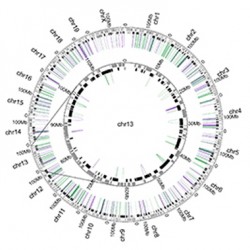By Helen Figueira
December 2, 2013
Time to read: 4 minutes
 How cohesin shapes the genome
How cohesin shapes the genome
In 1933, Dutch paediatrician Dr. Cornelia de Lange treated two children who were unrelated yet strongly resembled one another: both were small for their age, had proportionally smaller heads, hands and feet, and shared a multitude of developmental malformations. The symptoms were noted for the first time in medical literature, and the genetic disorder, Cornelia de Lange Syndrome (CdLS), became known. Affecting roughly 1 in 10,000 births, genetic mutations affecting the function of the protein complex cohesin lie at the heart of the disease. Now, new research from the CSC delves deep into the inner workings of cohesin and sheds new light into its intricate machinery.
Matthias Merkenschlager’s team (Lymphocyte Development Group) previously reported an important function of cohesin: when bound to a specific gene, the complex brought together regulatory elements that controlled that gene’s activity. Their latest study, published in Genome Research, reveals the effect this function has on a global scale across the entire genome. Lead author, Vlad Seitan explains, “Cohesin binds to tens of thousands of sites within the genome. When we showed that cohesin formed these intra-chromosomal interactions at one specific site, we became interested in how this function, added so many times over, would contribute to shaping the genome.”
In collaboration with Professor Job Dekker (University of Massachusetts Medical School) and Dr. Paul Flicek (Wellcome Trust Sanger Institute), Matthias’ team began investigating the chromosome architecture genome-wide and how it changed when cohesin was removed. “Chromosomes are divided into compartments that each encompass several million base pairs. This architectural organisation is thought to assist the regulation of gene expression. Essentially, genes and regulatory elements that are located within the same compartment are more likely to interact and influence each other’s activity. We used genetics to define the contribution of cohesin to these compartments and to long-range chromosomal interactions within them. We expected that removing cohesin from the chromosome would result in the overall structure to come apart. Surprisingly, this didn’t happen,” explains Matthias. Not content with this, Andre Faure, a computational biologist working with Paul Flicek at the Sanger Institute, looked in more detail at changes in genome organisation in cohesin-deficient cells. Interestingly, cohesin was required for directing the interactions between genes and regulatory elements that form within architectural compartments. “When we depleted cohesin and looked at gene activity, we saw that about 1000 genes within the genome began expressing at different rates. Two conclusions emerge from these findings: first, chromosomal compartments can exist without cohesin, and second, cohesin is important for the proper regulation of gene expression – simply ‘locking up’ genes and regulatory elements in chromosomal compartments is not sufficient,” states Matthias.
One remarkable thing Andre noticed was that genes that are normally highly expressed were often downregulated in the absence of cohesin, whereas genes normally silent began to show more activity when cohesin was depleted. In other words, gene expression became more ‘average’ without cohesin. Consequently, one important role for cohesin is in allowing each gene to be expressed at a specific rate. “This fine tuning means that if you have a gene that needs to be expressed at higher levels, cohesin will establish a chromatin structure to allow that to happen – and vice versa” adds Vlad.
Matthias’ group has helped to place cohesin at the scene of gene expression. The next challenge is to pinpoint the exact gene regulatory elements that are affected, and explain how cohesin controls their interactions.
YJ
Reference: Seitan, V. C., Faure, A. J., Zhan, Y., Patton, R., Lajoie, B. R., Ing-Simmons, E., Lenhard, B., Giorgetti, L., Heard, E., Fisher, A. G., Flicek, P., Dekker, J., & Merkenschlager, M. (2013). Cohesin-based chromatin interactions enable regulated gene expression within preexisting architectural compartments. Genome Research, 23 (12), 2066-2077.
This work was supported by the Medical Research Council, the Wellcome Trust, the European Molecular Biology Laboratory, the National Institutes of Health and the National Human Genome Research Institute.
The Medical Research Council has been at the forefront of scientific discovery to improve human health. Founded in 1913 to tackle tuberculosis, the MRC now invests taxpayers’ money in some of the best medical research in the world across every area of health. Twenty-nine MRC-funded researchers have won Nobel prizes in a wide range of disciplines, and MRC scientists have been behind such diverse discoveries as vitamins, the structure of DNA and the link between smoking and cancer, as well as achievements such as pioneering the use of randomised controlled trials, the invention of MRI scanning, and the development of a group of antibodies used in the making of some of the most successful drugs ever developed. Today, MRC-funded scientists tackle some of the greatest health problems facing humanity in the 21st century, from the rising tide of chronic diseases associated with ageing to the threats posed by rapidly mutating micro-organisms.